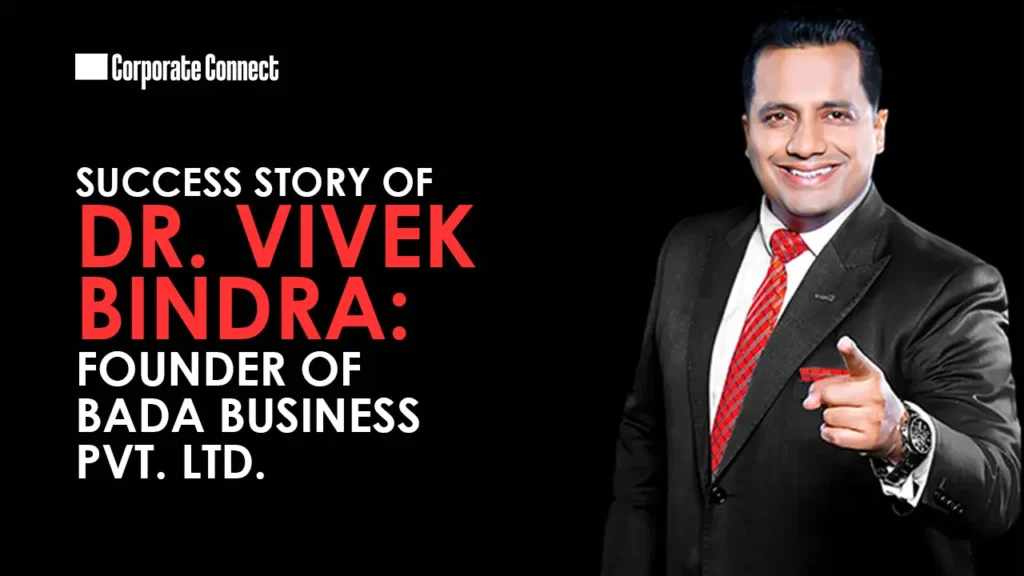Success Story of Dr. Vivek Bindra: How the Founder of Bada Business Pvt. Ltd. Revolutionized Entrepreneurial Learning in India
By Jaya Pathak
Dr. Vivek Bindra’s rise from a solo leadership coach to the founder of a large-scale entrepreneurial learning platform illustrates how credibility, distribution, and productmarket fit can align in India’s skills economy. His public persona—teacher, strategist, and evangelist for small-business growth—has been shaped by a content-first approach that converted attention into trust and trust into scalable programs under the Bada Business brand. The resulting enterprise straddles edtech, executive education, and performance coaching, targeting owners and operators in India’s micro, small, and medium enterprises (MSMEs).
1. Founding thesis and platform design
Bada Business Pvt. Ltd., launched and led by Dr. Bindra, positions itself as an affordable, vernacular-first business education provider focused on “burning problems” that most small firms face: sales pipelines, working capital, digital customer acquisition, distribution, and compliance. The model blends recorded modules, live workshops, and community touchpoints, framed as practical playbooks rather than abstract theory. Over time, the portfolio expanded into structured offerings such as leadership funnels and entrepreneurship primers, often branded through flagship programs and marquee webinars. The product design reflects a deliberate choice to prioritize applicability over credentialism.
2. Audience building through content
The engine of distribution has been long-horizon content creation across video-first channels, with Dr. Bindra’s Hindi-led communication style widening access for nonmetro entrepreneurs. Video case studies, sector primers, and tactical checklists created a free front door that nurtured familiarity before any sale. The channel’s cumulative reach and subscriber scale gave the company a reliable, low-CAC funnel, enabling upsell to deeper coursework and workshops without overreliance on paid advertising. That audience strategy—educator first, marketer second—undergirded the brand’s proposition as a coach for aspiring founders and small-business owners.
3. Go-to-market and program architecture
Go-to-market execution leaned on three levers. First, high-frequency digital sessions that created cadence and habit among viewers. Second, modular course architectures that allowed learners to onboard at different starting points—finance basics, digital marketing, sales management—without prerequisite formal education. Third, periodic large-format webinars that signaled scale and reinforced community, aligning with positioning as a national platform for entrepreneurship skills. This triad—cadence, modularity, community—helped the brand move beyond one-off seminars to repeatable learning journeys.
4. Founder as product
Dr. Bindra’s on-camera presence—high energy, anecdotal pedagogy, and mnemonicdriven instruction—functions as a recognizable product feature. His role spans content creation, program design, and brand stewardship, enabling rapid iteration from audience feedback into curriculum adjustments. In a market where trust is the gating constraint, the founder’s visibility has acted as both a differentiator and a quality control signal, especially for first-time buyers of business education. The founder-asproduct approach is reinforced by an executive coaching legacy and public positioning as an advisor to corporate leaders, which the brand uses to convey authority.
5. Scale and institutionalization
As the platform matured, Bada Business codified a portfolio of programs, formalized cohorts, and pushed “problem-solving courses” with industry practitioners. The organization narrative emphasizes accessibility—price points calibrated for MSMEs, content in Hindi, and toolkits for immediate use. Institutional elements—sales operations, partner networks, and event-driven lead generation—have supported predictable intake cycles. In public-facing materials, the company highlights marquee events and records associated with large webinars, signaling an ability to mobilize nationwide audiences at short notice.
6. Reputation dynamics and scrutiny
Prominence invites scrutiny. Petitioners have pursued legal remedies alleging deceptive practices tied to marketing claims, prompting media coverage and court notices; such matters reflect the broader tension in India’s informal training market between aggressive promotion and evolving norms of consumer protection. Subsequent reporting records differing procedural outcomes, underscoring that public narratives around fast-scaling education ventures are often contested and legally complex. For magazine editors, mention of such disputes benefits from precise, timestamped citations and neutral phrasing that distinguishes allegation from adjudication.
7. Impact on the skills ecosystem
Notwithstanding debate, the platform’s footprint within entrepreneurship education is notable for its attempt to translate management concepts into operational playbooks for first-generation founders. By framing instruction around practical sequences—lead generation to conversion, inventory control to cash cycles—the model lowers the barrier for informal entrepreneurs to adopt structured methods. This contributes to a larger movement in India to formalize small-business practice without imposing the costs of traditional degree programs, particularly for owners with time and capital constraints.
9. What the journey signals
Three features of this journey stand out for business readers. First, distribution strategy as core IP: audience-first brands can convert trust into diversified revenue if content quality remains consistent. Second, vernacular and affordability as growth levers: markets expand when instruction meets entrepreneurs where they are—linguistically, geographically, and financially. Third, institutional guardrails: as scale rises, governance and advertising standards become strategic, not merely legal, shaping durability and reputation in a crowded category. These features generalize beyond education into any sector where expertise must cross the last mile to millions.
conclusion
category’s future will likely be shaped by clearer consumer disclosure norms, thirdparty validation of outcomes, and credential pathways recognized by industry bodies. For Bada Business, this suggests opportunities in standardized assessments, employer partnerships, and data-backed claims that tie coursework to measurable performance. Continued investment in practitioner-led modules and regionalization could deepen retention, while stronger compliance processes may convert scrutiny into institutional credibility. The platform’s growth trajectory will hinge on its ability to balance reach with rigor as India’s skills infrastructure matures.
FAQ:
1. Who is Dr. Vivek Bindra?
Dr. Vivek Bindra is a leadership coach, motivational speaker, and entrepreneur. He is the founder of Bada Business Pvt. Ltd., a platform that provides affordable business education, particularly targeting India’s micro, small, and medium enterprises (MSMEs).
2. What is Bada Business Pvt. Ltd.?
Bada Business is an edtech and entrepreneurial learning platform offering practical business playbooks. It focuses on solving real-world challenges for small businesses, including sales, finance, digital marketing, customer acquisition, and compliance.
3. What makes the platform different from traditional business education?
Unlike degree-driven programs, Bada Business emphasizes practical applicability over credentialism. Its programs use Hindi and vernacular languages, affordable pricing, and structured toolkits, making them accessible to first-time and non-metro entrepreneurs.
4. How does Bada Business deliver its programs?
The platform uses a mix of:
-
Recorded video modules
-
Live workshops and webinars
-
Community-driven touchpoints
This modular approach allows entrepreneurs to join at different skill levels.
5. How did Dr. Bindra build his audience?
Through a content-first strategy, particularly on YouTube and other video platforms. His Hindi-led case studies, checklists, and motivational content built trust with millions, creating a low-cost acquisition funnel for deeper paid programs.
6. What is Dr. Bindra’s teaching style?
He uses high energy, storytelling, mnemonics, and real-world anecdotes. His on-camera presence is central to the brand, with his personal credibility functioning as a “product feature” for the company.
7. What kinds of programs does Bada Business offer?
The offerings include:
-
Leadership funnels
-
Entrepreneurship primers
-
Problem-solving courses (finance, digital marketing, sales, etc.)
-
Flagship large-scale webinars with industry experts
8. Who is the target audience for Bada Business?
The platform primarily caters to MSME owners, aspiring entrepreneurs, and small business operators across India who may not have access to formal management education.
9. Has Bada Business faced any controversies?
Yes. Some legal petitions and media reports have alleged misleading marketing practices. Outcomes have varied across cases, reflecting the challenges of regulating fast-growing informal education markets. It’s important to distinguish between allegations and adjudicated findings.
10. How does Bada Business impact India’s skills ecosystem?
By providing affordable, vernacular-first, and operationally focused content, the platform lowers barriers for small entrepreneurs to adopt structured management practices. This contributes to India’s broader goal of strengthening the MSME sector.
11. What lessons does Dr. Bindra’s journey offer for other startups?
-
Distribution is core IP: Building a trusted audience is as valuable as the product.
-
Affordability and language matter: Meeting entrepreneurs at their level expands markets.
-
Governance and compliance are key: As companies scale, credibility depends on transparent practices and consumer safeguards.
12. What is the future outlook for Bada Business?
The platform’s growth will depend on:
-
Stronger governance and compliance
-
Practitioner-led modules
-
Regional language expansion
-
Partnerships with industry bodies and employers
-
Data-backed claims linking training to measurable outcomes
13. How does Bada Business balance online and offline learning?
Bada Business combines digital-first delivery with occasional offline workshops and seminars. This hybrid approach allows entrepreneurs to learn at their own pace while also engaging in live problem-solving sessions and networking opportunities.
14. What role does vernacular content play?
The use of Hindi and other regional languages significantly expands the reach of the platform. By speaking the language of the audience, Bada Business ensures accessibility and higher comprehension, especially among non-metro MSME owners.
15. How does the platform ensure practical learning?
All programs are designed as actionable playbooks, with step-by-step guides, checklists, templates, and case studies. The goal is to translate theoretical concepts into implementable solutions immediately applicable in real business scenarios.
16. What is the pricing strategy of Bada Business?
The platform follows a tiered, affordable pricing model, making advanced business education accessible to small business owners. Free content serves as the first touchpoint, while premium workshops and structured courses generate revenue without excluding price-sensitive segments.
17. How does Dr. Bindra’s personal brand influence the company?
Dr. Bindra’s visibility and credibility are central to the brand’s identity. His energetic teaching style, relatable examples, and public persona act as trust signals, reducing friction for first-time learners and increasing engagement across programs.
18. How has Bada Business scaled its operations?
The company institutionalized its operations by:
-
Formalizing cohorts and course schedules
-
Developing partner networks for content dissemination
-
Implementing lead-generation and sales operations
-
Tracking learner outcomes to ensure measurable impact
19. What industries benefit most from Bada Business programs?
While primarily aimed at MSMEs, the platform’s teachings are applicable to:
-
Retail and e-commerce
-
Manufacturing and production units
-
Service industries (consulting, hospitality, education)
-
Startups and small enterprises looking to scale operations
20. Are there career or growth opportunities for learners?
Yes. Learners gain:
-
Practical knowledge to improve business performance
-
Networking opportunities with peers and industry mentors
-
Tools and templates to streamline operations, marketing, and finance
21. What challenges has Bada Business faced in scaling?
-
Navigating legal and regulatory scrutiny
-
Maintaining content relevance across industries
-
Scaling instructor quality while keeping content affordable
-
Balancing rapid growth with operational consistency
22. How does the platform stay updated with market trends?
Bada Business leverages real-time feedback, industry case studies, and practitioner input to update its courses. This ensures content aligns with the evolving needs of MSMEs in India.
23. How does Bada Business contribute to India’s entrepreneurship ecosystem?
By democratizing business education, the platform:
-
Reduces the knowledge gap for first-generation entrepreneurs
-
Encourages formalized business practices in informal sectors
-
Promotes self-employment and skill development across the country
24. Can Bada Business content be accessed internationally?
Yes, the online nature of the platform allows global access, particularly for NRIs or entrepreneurs looking to replicate India-centric business models abroad.
25. What are the long-term goals of Bada Business?
-
Expand regional-language content
-
Partner with corporates and government skill programs
-
Introduce measurable credentials and certifications
-
Strengthen the institutional credibility of informal business education
26. How does Bada Business maintain learner engagement online?
The platform uses interactive video content, quizzes, live Q&A sessions, and gamified learning modules to ensure that entrepreneurs remain engaged. Short-form content and real-life examples help retain attention and reinforce key concepts.
27. What types of certifications or recognition does Bada Business provide?
Learners completing structured programs receive certificates of completion that can enhance credibility with clients, investors, and employees. These credentials are designed to signify practical knowledge rather than traditional academic achievements.
28. How does Bada Business support startups with limited budgets?
The platform provides free workshops, downloadable toolkits, and affordable tiered courses, enabling cash-strapped startups to access professional guidance without incurring prohibitive costs.
29. What industries does Dr. Bindra’s content cater to most effectively?
While content is universally applicable, it is especially useful for:
-
Retail chains and e-commerce businesses
-
SMEs in manufacturing, logistics, and supply chain
-
Service sectors like education, hospitality, and consultancy
-
Small enterprises needing guidance in marketing, sales, and finance
30. How does Bada Business measure the success of its programs?
Success is measured through:
-
Learner feedback and ratings
-
Implementation of taught strategies in real business scenarios
-
Revenue growth and operational improvements in participant businesses
-
Engagement metrics from online platforms (views, watch time, repeat visits)
31. How does the platform differentiate itself from competitors?
-
Vernacular-first approach: Makes education accessible to non-English speakers
-
Founder-led content: Dr. Bindra’s personal brand adds authority
-
Actionable focus: Courses are structured as “playbooks” rather than theory-heavy lessons
-
Hybrid delivery: Combines online modules with live sessions for practical application
32. Are there community support options for learners?
Yes. Bada Business offers online communities, peer groups, and alumni networks where learners can share experiences, ask questions, and network with like-minded entrepreneurs.
33. How frequently is the content updated?
Courses and modules are regularly updated to reflect changing market dynamics, digital marketing trends, taxation policies, and business innovations, ensuring learners remain relevant and informed.
34. Can employees of MSMEs benefit from Bada Business programs?
Absolutely. Team members, junior managers, and operational staff can also benefit, improving overall organizational efficiency, leadership development, and revenue growth.
35. What role does technology play in Bada Business’ operations?
The platform leverages:
-
Video-first learning for easy consumption
-
AI-powered recommendations for course suggestions
-
Data analytics to track engagement, measure ROI, and refine programs
-
Mobile-friendly design for entrepreneurs on-the-go
36. How does Bada Business impact India’s informal economy?
By providing structured guidance, the platform formalizes processes in sectors that traditionally operate informally. This improves compliance, efficiency, and access to financial and digital tools for small businesses.
37. Are there success stories or case studies available?
Yes. Bada Business publishes real-life case studies and testimonials showcasing entrepreneurs who have scaled operations, increased sales, or optimized processes using strategies learned from the platform.
38. How does Dr. Bindra maintain content credibility?
Credibility is maintained by:
-
Sharing practical experiences and personal insights
-
Featuring verified industry experts in workshops
-
Using evidence-backed examples and frameworks
-
Encouraging learners to implement concepts and report measurable results
39. Can international audiences access the platform?
Yes. While tailored to the Indian MSME ecosystem, content is accessible globally, particularly for NRIs and international entrepreneurs interested in Indian business practices.
40. What’s next for Bada Business in terms of growth?
Future plans include:
-
Expanding regional-language courses
-
Partnering with government skill development initiatives
-
Introducing assessments and accredited certifications
-
Strengthening B2B offerings for enterprises and corporate clients
Read Also: Top 10 Richest Indian Music Directors in 2025










